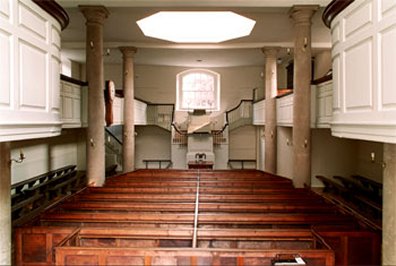 |
||||||||||
 |
||||||||||
|
1173: The New Room, Bristol,
England Mystery Worshipper: Leo. The church: The New Room (John Wesley's Chapel), Bristol, England. Denomination: Methodist. The building: John Wesley came to Bristol in 1739 and started preaching in the open air. He and other preachers were often set upon by angry or drunken mobs; Wesley himself was stoned, beaten to the ground and dragged by the hair. The faithful soon formed religious societies that met in people's homes. Within weeks their numbers had increased so much that a new meeting place was needed. Wesley bought a small patch of land and built what he called "our new room in the Horsefair". It was used as a dispensary and schoolroom for the poor as well as for meetings and worship. It is still known today by Methodists as The New Room. In 1748 it was extended and rebuilt. It is the oldest Methodist building in the world. The church: There is no regular Sunday service, hence no congregation. During the week the building is open as a sort of museum. The neighbourhood: The New Room is set in Broadmead, Bristol's noisy, bustling shopping centre. The cast: The minister was David Weeks, and the sermon was given by Mark Topping, curator of the New Room. The date & time: Friday, 21 October 2005, 1.00pm. What was the name of the service? Holy Communion. How full was the building? I counted 17 people. Did anyone welcome you personally? Yes. I had been attending a series of lectures throughout the week for Black History Month, and a man who had been greeting people at the lectures each day recognised me and nodded to me as I entered. Was your pew comfortable? No. I sat in a box pew that did not have enough room for the average bottom and spent most of the time changing posture in a vain attempt to find something vaguely comfortable. However, it could have been worse. The previous Monday the chapel was packed out by 400 people who had come to listen to ex-MP Tony Benn, and I had to sit on a bench with no back. How would you describe the pre-service atmosphere? The service was preceded by the curator acting the part of John Wesley. He preached Wesley's sermon against slavery. During the five minute break between this and the service, people were chatting and saying their goodbyes. Once they had left, there was an intense silence which was most conducive to prayer. What were the exact opening words of the service? "Good afternoon and welcome to our Friday communion service." What books did the congregation use during the service? A leaflet entitled An Order for Holy Communion. What musical instruments were played? None. Did anything distract you? The ticking of a huge clock on the north side of the gallery. Was the worship stiff-upper-lip, happy clappy, or what? Quietly recollected. Exactly how long was the sermon? The re-enacted John Wesley sermon, as a prelude to the service, was 20 minutes. The sermon after the gospel was 4.5 minutes. On a scale of 1-10, how good was the preacher? 10 – Mark Topping did not use any notes but had learned Wesley's sermon off by heart and preached it very effectively. The minister, David Weeks, also did not use notes. In a nutshell, what was the sermon about? Wesley's sermon was directed at slave owners, urging them, from Psalm 95, to "harden not your hearts". The minister preached on "Render unto Caesar that which is Caesar's" and said that for too long the Church had colluded with the establishment to justify institutions such as slavery. I found this relevant both to the gospel for the day and the Black History theme. Which part of the service was like being in heaven? The peace and quiet of the place, despite its setting in a busy shopping centre. And which part was like being in... er... the other place? I felt guilty for having been, as an Anglo-catholic, a strong opponent of Anglican-Methodist unity in the past. Also, I have been strongly indoctrinated to doubt the validity of Methodist orders and sacraments, so I asked myself on the one hand, "What am I doing receiving Methodist communion?" while at the same time telling myself not to be so silly. What happened when you hung around after the service looking lost? People did not hang about because they were, mostly, going back to work. The minster gave me a fairly limp handshake and said it was nice to see me. How would you describe the after-service coffee? There was none. It was a lunchtime service. How would you feel about making this church your regular (where 10 = ecstatic, 0 = terminal)? 4 – I might go again to the lunchtime service. Did the service make you feel glad to be a Christian? Yes – and somewhat of a dissenting one like the early Methodists. What one thing will you remember about all this in seven days' time? The peace and quiet. |
|
|
||||||||||||||||||||||||||||||||||||
| More Mystery Worshipper reports | |||||||||||||||||||||||||||||||||||||||
 |
|||||||||||||||||||||||||||||||||||||||






